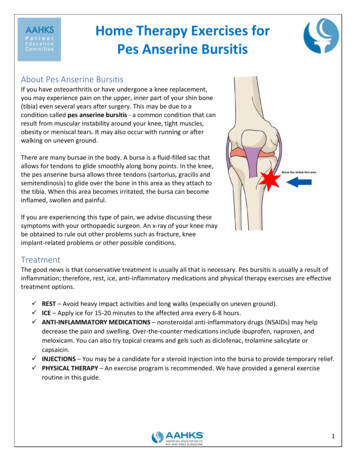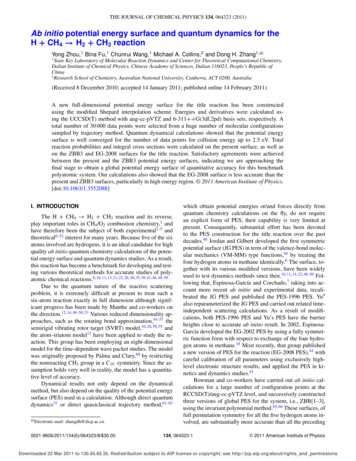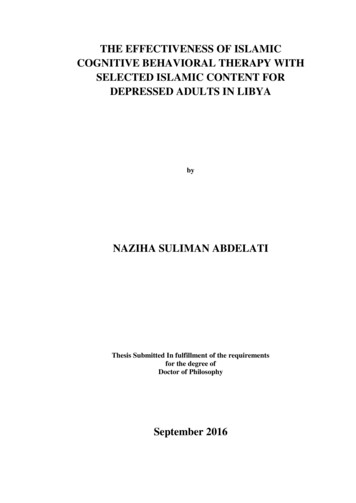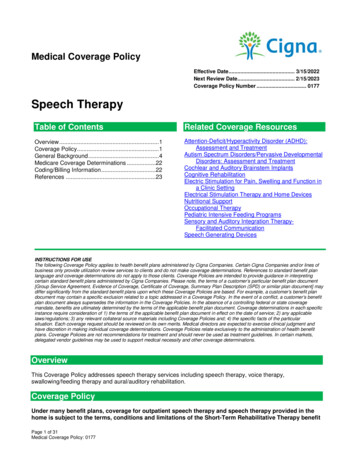
Transcription
Home Therapy Exercises forPes Anserine BursitisAbout Pes Anserine BursitisIf you have osteoarthritis or have undergone a knee replacement,you may experience pain on the upper, inner part of your shin bone(tibia) even several years after surgery. This may be due to acondition called pes anserine bursitis - a common condition that canresult from muscular instability around your knee, tight muscles,obesity or meniscal tears. It may also occur with running or afterwalking on uneven ground.There are many bursae in the body. A bursa is a fluid-filled sac thatallows for tendons to glide smoothly along bony points. In the knee,the pes anserine bursa allows three tendons (sartorius, gracilis andsemitendinosis) to glide over the bone in this area as they attach tothe tibia. When this area becomes irritated, the bursa can becomeinflamed, swollen and painful.If you are experiencing this type of pain, we advise discussing thesesymptoms with your orthopaedic surgeon. An x-ray of your knee maybe obtained to rule out other problems such as fracture, kneeimplant-related problems or other possible conditions.TreatmentThe good news is that conservative treatment is usually all that is necessary. Pes bursitis is usually a result ofinflammation; therefore, rest, ice, anti-inflammatory medications and physical therapy exercises are effectivetreatment options. REST – Avoid heavy impact activities and long walks (especially on uneven ground). ICE – Apply ice for 15-20 minutes to the affected area every 6-8 hours. ANTI-INFLAMMATORY MEDICATIONS – nonsteroidal anti-inflammatory drugs (NSAIDs) may helpdecrease the pain and swelling. Over-the-counter medications include ibuprofen, naproxen, andmeloxicam. You can also try topical creams and gels such as diclofenac, trolamine salicylate orcapsaicin. INJECTIONS – You may be a candidate for a steroid injection into the bursa to provide temporary relief. PHYSICAL THERAPY – An exercise program is recommended. We have provided a general exerciseroutine in this guide.1
PreventionIt is known that “an ounce of prevention goes a long way.” To potentially prevent pes anserine bursitis, it isimportant to keep good muscular balance around the knee. Additionally, warming up before exercise isadvised to include stretching of the muscles along the front, back, and inside portion of the thigh and knee. Itis always important after surgery or a period of relative inactivity to slowly increase your exercise level overtime. This will help prevent bursitis and other conditions that can occur with returning to physical activity tooquickly. Remember, “slow and steady wins the race!”The American Association of Hip and Knee Surgeons (AAHKS) has outlined this home exercise program for youto treat your pes anserine bursitis. The exercises will focus on stretching, strengthening and endurance.If you do not experience relief after three months of following this routine, a follow up visit with your doctor isrecommended. It is ultimately up to you and your surgeon to find a routine that is most appropriate for yourrecovery. Your surgeon may recommend alterations to this routine. If you experience any abnormaldiscomfort or begin to feel ill during any exercise, we advise you to stop exercising and contact your surgeonas soon as possible.DISCLAIMERPLEASE USE THE EXERCISES AS A GUIDE AS IT IS ULTIMATELY BETWEEN YOU AND YOUR SURGEON TODECIDE WHICH THERAPY SETTING IS RIGHT FOR YOUR TREATMENT COURSE. IF YOU EXPERIENCE ANYABNORMAL DISCOMFORT, DIZZINESS, OR FEELINGS OF PASSING OUT, PLEASE STOP EXERCISING ANDCONTACT YOUR PHYSICIAN AS SOON AS POSSIBLE.2
STRETCHING EXERCISESStretching helps to prevent injury by getting the muscles ready for a workout. Typically, you should spend 5-10minutes stretching before exercising. A heating pad or warm towel can be used to help relax the muscles inpreparation for stretching. Massaging in a topical cream prior starting may also help in the process of gettingwarmed up. The following stretches can also be performed in between exercises to keep the muscles fromgetting tight. Your exercise program should start and finish with stretches. Ice can be applied to the knee orsore muscles after exercising.GENERAL TIPS FOR STRETCHING EXERCISES Warm-up by walking 5-10 minutes to get your muscles ready for exercising. Remember to stretch in a slow and controlled manner: avoid rapid motions. Perform each stretch until you experience a “tolerable discomfort” in the muscle –adjust the stretch to your comfort. Try to hold the position for 10-30 seconds. Slowly return to the starting position. Take a deep breath and relax for 5 seconds between repetitions. Cool-down: 5-10 minutes of icing or slow walking to finish workout.You can expect some muscle soreness when you first start a stretching program.3
HAMSTRING STRETCHSEATEDThe hamstrings are a group of muscles on the back of your thigh. It is important to stretch these musclesbecause they can become tight after knee replacement. This stretch is also used during warm-ups to get yourmuscles ready for other exercises. There are a few ways to perform a hamstring stretch. It is important to tryto relax during stretching exercises. Do not hold your breath. Instead focus on taking slow deep breaths whiletrying to stretch a little bit further. Remember to keep your toes pointed towards the ceiling at all times. Thesestretches can be performed lying down on your back, sitting or standing. It is important to find a position thatworks well for you.1. Begin by sitting in a hardback chair; prop your leg ona stool or chair directly in front of you.2. While keeping your back straight, slowly reach foryour toes while at the same time keeping your kneestraight. You will feel a stretch along the muscles in theback of your thigh.3. Try to hold for 30 seconds.4. Slowly return to the starting position.This exercise should be performed on bothlegs.SETSREPETITIONSHOLD3130 Seconds4
HAMSTRING STRETCHADDITIONAL OPTIONSHere are two other methods of stretching the hamstring muscles that you can do while lying on yourback or standing. You can use any position that is most comfortable for you. It is important to try to relaxduring stretching exercises. Do not hold your breath. Instead focus on taking slow deep breaths whiletrying to stretch a little bit further.1. While lying on your back, place a towel or cord aroundthe bottom of your foot.2. While keeping your knee straight, slowly pull your legin an upward direction using the towel to pull higher. Youwill feel a stretch along the muscles in the back of yourthigh.3. Try to hold for 30 seconds.4. Slowly return to the starting position.OR1. While standing, place your foot on a stool or chair.2. While keeping your knee straight, slowly bend forwardto touch your toe. You will feel a stretch along themuscles in the back of your thigh.3. Try to hold for 30 seconds.4. Slowly return to the starting position.This exercise should be performed on both legsSETSREPETITIONSHOLD3330 Seconds5
CALF STRETCHThis exercise stretches the calf muscles. These muscles can become tight after knee replacement. Thisstretch is also used during warm-ups to get your muscles ready for other exercises. You will need to leannext to a wall or door to complete this stretch. There are a few ways to perform the calf stretch. It isimportant to try to relax during stretching exercises. Do not hold your breath. Instead focus on taking slowdeep breaths while trying to stretch a little bit further. This stretch can be performed two different ways1. Stagger your stance with one foot in front of the other.2. Keep the toes of both feet pointed forward while your hands on the wall/door – be sure to keepyour back knee straight with the heel on the ground at all times.3. Slowly lean forward until you feel a stretch in the back of your calf.4. Hold for a minimum of 5 seconds and up to 30 seconds for a good stretch.5. Relax and take a deep breath for 1-2 seconds.6. Repeat 5 times to complete one set.7. Switch to the opposite leg and repeat.This exercise should be performed on both legs.SETSREPETITIONSHOLD3330 Seconds6
QUADRICEPS STRETCHThe Quadriceps are a group of muscles on the front of your thigh. This stretch should be performed severaltimes a day to help keep the muscles flexible. This stretch is also used during warm-ups to get yourmuscles ready for other exercises. There are two ways to perform the quadriceps stretch. It is important totry to relax during stretching exercises. Do not hold your breath. Instead focus on taking slow deep breathswhile trying to stretch a little bit further. For this exercise you will need to use a chair or countertop forbalance.1. Begin by grabbing our knee with your hand asyou balance on the opposite foot.2. Slowly pull your foot toward your buttocksuntil you experience a tolerable stretch alongthe front of your thigh.3. Try to hold for 30 seconds4. Slowly return to the starting positionThis exercise should be performed on both legsSETSREPETITIONSHOLD3330 Seconds7
HIP ADDUCTOR STRETCHThis hip adductors are a group of muscles on the inner part of your thigh. This stretch is also used duringwarm-ups to get your muscles ready for other exercises. It is important to try to relax during stretchingexercises. Do not hold your breath. Instead focus on taking slow deep breaths while trying to stretch alittle bit further. This stretch can be performed in two different ways - lying on your back or sitting on thefloor.1. We recommend lying on your back.2. Remember to keep your toes pointed toward the ceiling andyour knee straight3. Slowly move your leg out to the side until a comfortablestretch is felt in your groin.4. Try to hold for 30 seconds.5. Slowly return to the starting positionOR1. We recommend sitting on the floor or a firm surface.2. Put your feet together and sit with your back straight. Placeyour hands on your knees.3. Slowly press your knees down towards the floor until acomfortable stretch is felt in your groin.4. Try to hold for 30 seconds.5. Slowly return to the starting position.This exercise should be performed on both legsSETSREPETITIONSHOLD3330 Seconds8
STRENGTHENING EXERCISESThese exercises can help muscles build strength as well as improve the nerve signals to improve strength andfunction. It is important to exercise the leg muscles in different ways to improve overall function. Exercisebands or ankle weights can be added to most of these exercises to increase the degree of difficulty.General Tips for Stretching Exercises Strengthening exercises are usually performed after warm-up and stretching.Please use the “Sets, Repetitions, Hold” as a guide during exercising.Remember to control the muscles to slowly return to the original starting position.Take a deep breath and relax for 5 seconds between repetitions.It important to take 5-10 minutes to cool-down after exercising. This should includestretches and applying ice to sore muscles.Slight muscle discomfort can be expected - these exercises SHOULD NOT CAUSE PAIN. If youdo experience pain, back off and modify your technique. If pain is still present, werecommend avoiding the particularly painful exercise.9
QUAD SETSThe Quadriceps are a group of muscles on the front of your thigh. To perform this exercise, werecommend lying on you back on a soft surface or mat. Place a small towel or pillow behind your knee.1.Keep your toes pointed toward theceiling and slowly push the back of yourknee down into the towel/pillow. You willfeel your thigh muscles tighten.2.Hold the muscle contraction for 5seconds before slowly relaxing andreturning to the starting position.This exercise should be performed on both legs.SETSREPETITIONSHOLD3105 Seconds10
QUAD ARCSThe Quadriceps are a group of muscles on the front of your thigh. To perform this exercise, werecommend lying on you back on a soft surface or mat. For this exercise, place a rolled-up towel or pillowbehind your knee that allows your knee to rest in a comfortable bent position.1. With your toes pointed toward the ceiling, slowly straighten your knee while keeping the back of yourknee on the towel/pillow. You will feel your thigh muscles tighten.2. Try to hold the muscle contraction for 5 seconds with the knee straight.3. Next slowly relax the thigh muscles and allow the leg to return to the starting position.This exercise should be performed on both legs.SETSREPETITIONSHOLD3105 Seconds11
SIDELYING ADDUCTIONThis exercise will work your muscles on the inside of your thigh. We recommend lying on your side on acomfortable mat or firm surface. Remember to keep you back straight for this exercise. You can use yourarms for balance during this exercise.1. Start by crossing your upper leg over your lower leg.2. While keeping your knee straight, slowly raise your lower leg toward the ceiling. (You will feelyour inner hip muscles tighten)3. Try to hold the end position for 5 seconds before lowly returning your leg to the startingpositionThis exercise should be performed on both legs.SETSREPETITIONSHOLD3105 Seconds12
STRAIGHT LEG RAISEThis exercise works the quadriceps (thigh) muscles. To perform this exercise, we recommend lying on yourback on a soft surface or mat. To take pressure off your back, your opposite leg should be comfortablyresting in a bent position with the foot on the ground.1. Begin by tightening your thigh muscles with your toes pointed toward the ceiling.2. Slowly lift your entire leg off the ground while keeping your knee straight.3. Try to bring your leg up until your thighs are at the same level.4. Try to hold your leg up for 5 seconds and then slowly return your leg to the starting position.This exercise should be performed on both legs.SETSREPETITIONSHOLD3105 Seconds13
PRONE KNEE BENDSThis exercise works the hamstring muscles on the back of your thigh. To perform this exercise, we recommendlying on your stomach on a comfortable surface. Keep the front part of your thigh in contact with the surfaceat all times. Ankle weights or exercise bands can be added to increase the degree of difficulty.1. Point your toes away as if you were pushing ona gas pedal2. Slowly bend your knee up until your lower legpoints towards the ceiling.3. Hold the bend for 5 seconds before slowlyreturning your leg to the starting position.This exercise should be performed on both legs.SETSREPETITIONSHOLD3105 Seconds14
HEEL SLIDESThis exercise works the quadriceps (thigh) and hamstring muscles. To perform this exercise, we recommendlying on you back on a soft surface or mat. We also recommend performing this exercise while wearing socksso your foot can slide easier. Remember to keep your knee pointing toward the ceiling at all times.1. Slowly bend your knee and slide your heel back toward your buttock until a comfortable pull is feltat the front of your knee.2. Try to hold the position for 5 seconds before slowly pushing your knee straight until the back of yourknee rests against the surface.A strap can also be used to help slide your heel further to increase the stretch on the knee.This exercise should be performed on both legs.SETSREPETITIONSHOLD3105 Seconds15
WALL SQUATSThis is a common exercise meant to strengthen you back, hips and legs muscles. Using the wall keepsthe low back and shoulders in good postural alignment. Holding an abdominal muscle contractionduring the exercise helps ensure core muscular conditioning. To make the exercise harder, an exerciseball can be used between your back and the wall.1. Begin with your feet about shoudler-width apart and about 18 inches form the wall.2. Start by slowly bending your knees and sliding your back down the wall until your knees are at acomfortable bend.3. Be sure to keep you back and shoulders against the wall.4. Try to hold for a minimum of 5 seconds.5. Slowly return to the starting pose (slide back up the wall).6. Relax and take a deep breath for 1-2 seconds.7. Repeat 5-10 times to complete one set.SETSREPETITIONSHOLD3105 Seconds16
PRONE KNEE EXTENSIONThis exercise works the buttock, hamstring and calf muscles along the entire leg. To perform this exercise,we recommend lying on your stomach on a comfortable surface. Ankle weights or exercise bands can beadded to increase the degree of difficulty.1. Point your toes away as if you were pushing on a gas pedal.2. Slowly lift your entire leg off the table while trying to keep your knee straight.3. Hold for 5 seconds before slowly returning your leg to the starting position.This exercise should be performed on both legs.SETSREPETITIONSHOLD3105 Seconds17
HIP ABDUCTION / ADDUCTIONThis exercise will work your muscles on the outside of your hip and thigh. When performing this exercise,we recommend using a chair, counter, or railing for balance. Remember to keep you back straight for thisexercise.Standing1. Begin by slightly rotating your toes toward the side.2. While keeping your knee straight, slowly move your leg out toward theside. You will feel the muscles on the side of your hip tighten.3. Try to hold the end position for 5 seconds before slowly returning yourleg to the starting position.Sidelying4. Start by rotating your toes so they are pointing towards theceiling.5. While keeping your knee straight, slowly raise your leg toward theceiling until a comfortable stretch is felt in your groin. You will feelyour outer hip muscles tighten.6. Try to hold the end position for 5 seconds before lowly returningyour leg to the starting position.Ankle weights or exercise bands can be added to increase the degree of difficulty.This exercise should be performed on both legs.SETSREPETITIONSHOLD3105 Seconds18
PHYSICAL THERAPY – An exercise program is recommended. We have provided a general exercise routine in this guide. 2 Prevention It is known that “an ounce of prevention goes a long










